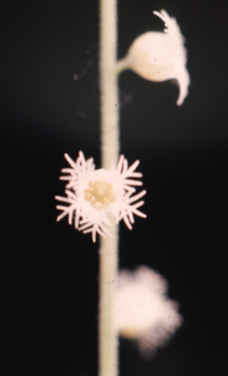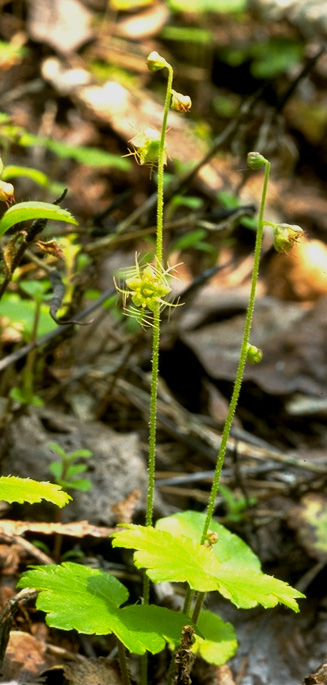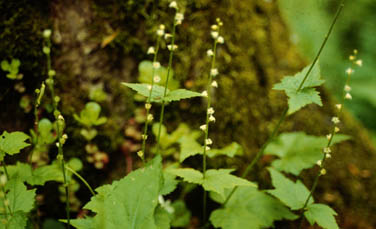
(photographed by Hugh Wilson)
(back to family page) (back to genus page)
| Table of Contents:
|

(photographed by Hugh Wilson) |
General Description and Related Species
Mitella diphylla is a "small flowering plant that appears in April
and May at elevations up to 2500 feet. On average the plant grows
6-16'' high and prefers moist, rich wooded slopes and stream banks.
This small woodland plant bears creamy, white flowers which cling to the
upper half of the 10 to 15 inch stem in a long raceme." (Campbell,
Hudson & Sharp) "The petals of the flowers are delicately
fringed so that each flower resembles a snowflake.
The stem has a single pair of nearly stalkless leaves in the middle each
with 3-5 lobes. The plant also supports long-stalked, heart-shaped
basal leaves." (Newcomb)
Higher
Taxa:
|
 |
| Identification: |
 |
|
|
|
|
| North America:
Continental United States; Canada |
|
|
| Eastern North America:
United States east of Mississippi; Ontario and Eastern Canada |
|
|
| Southeastern United States:
AL, AR, DE, FL, GA, KY, MD, NC, SC, TN , VA, WV |
|
|
| Coastal Plain |
|
|
| Piedmont |
|
|
| Blue Ridge Mountains |
|
|
| Great Smoky Mountains National Park |
|
|
| Ridge and Valley |
|
|
| Cumberland Plateau |
|
|
| Georgia |
|
|
| Clarke County, Georgia |
|
|
Natural History:
Mitella diphylla are small perennials from North America.
They "appear in April and May at elevations up to 2500 feet and may be
seen in Little River Gorge. The favorite habitat is moist, rich,
wooded slopes and stream banks." (Campbell, Hutson
& Sharp) These small plants are able to spread by runners,
soon covering the ground. They "flourish on damp soil in a cool half-shaded
spot. They make attractive ground-cover plants, and their flowers,
though inconspicuous, are exquisite." (Kohlein)
Mitella diphylla was first described by Linneas. This description
was published in the Species Plantea on page 406. Several specimens
are available for examination at the UGA herbarium. I was unable
to find any detailed information as the the means of pollination, seed
dispersal, etc. However, one can imagine that like many similar small
forest species, these may be through insects, small birds, the wind, etc.
In attempting to find Mitella diphylla
in the "wild," one would do well to search in forested portions of the
Eastern United States. They would most likely be found along stream
banks or any low-lying areas with ample moisture in a well-shaded area.
The most striking feature of these small plants from afar is probably the
central set of leaves.
They extend from the center of the stalk and are basically lacking petioles.
Another striking feature is the raceme arrangement of the flowers.
One specimen (presently in the UGA herbarium) was collected in Rabun County.
It was found on the North side of a wooded ravine along Darnell's Creek
just SE of Dillard, GA. The elevation was approximately 2250 ft;
this specimen was collected May 7, 1950 by G.W. McDowell and Wilbur H.
Duncan.
Another specimen of the herbarium was collected in Stephens County from
the North-facing slope of Tributary Creek on the South side of Panther
Creek. It was collected by James H. Groves on April 17, 1978.
( Morgan F. Smith)
Campbell, C., Hutson, W., Sharp,
A. 1970. Great Smokey Mountain Wildflowers.
The
University of Tennessee Press. Knoxville, TN
Gray, Asa. 1848.
A Manual of the Botany of the Northern US. Boston & Cambridge:
James Monroe and
Company, London.
Harned, J. 1936. Wildflowers
of the Aleghanies. Press of the Sincell Printing Company.
Oakland,
MD
Kohlein, F. 1984. Saxifrages and related genera. BT Batsford Ltd. London, England
Newcomb, L. 1977. Newcomb's
Wildflower Guide. Little, Brown & Company.
Boston,
MA
Radford, A., Ahles, H., Bell, C.
1968. Manual of the Vascular Flora of the Carolinas.
The University
of North Carolina Press. Chapel Hill, NC